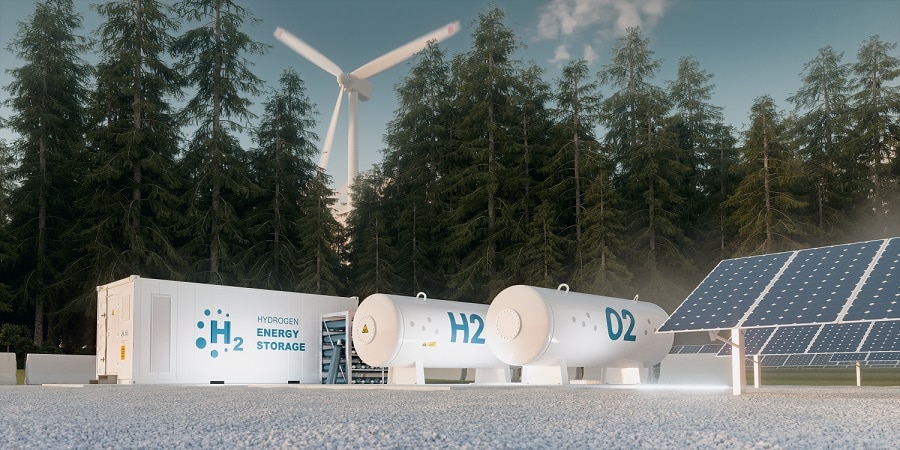
Is natural gas really eco-friendly?
Natural gas can be considered an eco-friendly alternative compared to coal and other fossil fuels. However, it doesn’t mean it has a low impact on the environment but rather highlights how dangerous and pollutant the usage of most fossil fuels is for the planet.
Methane, the principal component of natural gas, burns more efficiently than coal, making it a better option. Moreover, this gas remains in the atmosphere for nine to 12 years, far less than the decades for which carbon dioxide sticks around.
Other factors that influenced how the public opinion saw natural gas can be its abundance and the relatively low costs associated with exploitation.
Compared with what we call alternative energy sources, natural gas is less eco-friendly, making its usage a less effective way to reach climate neutrality in the long run. Natural gas burning still accounts for a significant amount of carbon dioxide emissions. Furthermore, methane leaks from natural gas extraction and transportation put people’s lives at risk and impact global climate change.
Ten years ago, natural gas was called the “bridge to a low-carbon future” when scientists believed it could smooth the shift from coal to more sustainable energy sources. However, as time passes and the consumption of natural gas continues to grow, data shows that methane emissions have a more significant impact on climate change than initially thought. Therefore, carbon-neutral alternatives become more critical as countries work toward reducing their carbon footprint.
What are natural gas alternatives?
Natural gas is the second-most used energy source in the US, used for industrial applications, heating, and electricity generation. Natural gas alternatives are energy sources that are interchangeable with conventional natural gas.
Most of these alternatives are considered more environment-friendly, as they have a relatively lower impact on the environment than natural gas. We can produce more sustainable energy while lowering greenhouse gas emissions.

Advantages and drawbacks of natural gas
Advantages:
- Natural gas is cheap compared to many alternatives.
- Burning natural gas results in lower carbon dioxide emissions than other fossil fuels.
- Natural gas is a reliable resource that doesn’t depend on weather conditions or seasons.
Disadvantages:
- Transportation and storage can be costly and dangerous.
- Natural gas is more environment-friendly than other fossil fuels, but it still produces significantly more greenhouse gas emissions than natural gas alternatives.
- Storage and transportation leak methane into the atmosphere throughout the entire supply chain, increasing the amounts of methane in the atmosphere.
- Most natural gas extraction relies on hydraulic fracturing, which can damage natural habitats.
Main types of natural gas substitutes
Wind energy
Wind energy provides between 10 and 30% of the electricity used in more than 20 states across the US, making it the most used alternative to natural gas in the last two years. This substitute is sustainable, as wind turbines don’t produce greenhouse gas emissions and aren’t associated with acid rain or smog.
One of the main problems with wind energy remains the high production costs. Investments in this area are growing, but wind energy continues to be effective when used in combination with other sources. Until windfarms don’t become low-cost alternatives, wind energy prices won’t be competitive enough on the market.
The downside of wind energy is the noise coming from wind turbines and the impact they can have on wildlife.
Solar energy
Solar power is a renewable energy source — as long as we don’t run out of sunshine, we can produce energy. Solar photovoltaic (PV) devices and PV power plants offer advantages by transforming sunlight into electricity. Depending on the dimensions of the system, they can power up thousands of homes and even industrial consumers.

HomeBiogas 2
Designed for the next generation of green innovation.
The efficiency of this technology has been continuously growing, while production costs are getting lower. Solar energy systems on buildings have a minimal impact on the environment and don’t produce carbon dioxide or other dangerous substances.
The problem with this energy source is the limitations that come with inconsistencies — the amount of sunlight varies depending on the time of day, season, location, and weather conditions.
Hydro energy
Hydropower is an affordable, eco-friendly energy source that can work in tandem with other renewables to secure consistent energy supplies throughout the year. Hydro energy has an excellent cost-benefit ratio, positively impacting energy price stability.
The infrastructure necessary for building hydro energy stations is a long-term investment, as these structures can be easily maintained and updated to serve multiple generations. Time has proven the benefits and reliability of this natural gas alternative.
Hydropower has a median greenhouse gas (GHG) emission intensity of 24 grams of carbon dioxide per kilowatt-hour of electricity generated, which is 20 times less than what the natural gas produces — the median figure for gas is 490 grams.

Geothermal energy
Geothermal energy produces a fraction of the greenhouse gas fossil fuels generate and is cost-effective overall, but initial costs are high. Moreover, the limited geographical areas where these resources are available and accessible make geothermal energy difficult to use at scale.
Nuclear energy
Nuclear energy is considered a clean and efficient resource, as nuclear power plants seem to be more reliable and productive than other facilities. They can produce high amounts of carbon-free energy in less space than any other clean-air source.
Moreover, the process generates minimal waste, and new technology makes it possible for used nuclear fuel to be reprocessed and recycled. Currently, 450 reactors are functional worldwide, generating about 10% of the world’s electricity.
Uses of natural gas and its alternatives
Natural gas is a valuable resource with a high impact on multiple aspects of our lives.
Natural gas can be used for:
- Generating electricity
- Process heating in the industrial sector
- Producing chemicals, fertilizer, and hydrogen
- Heating buildings and water
- Cooking and drying clothes
- Operating compressors
- Vehicle fuel
While not natural gas alternatives are universal substitutes, a mix of energy sources can reduce the need to use natural gas to a minimum.
Natural gas alternatives for your house
Rooftop solar panels
Rooftop solar panels are best used for heating water. House owners can also store the energy or even sell it to the national electricity grid. The National Renewable Energy Laboratory (NREL) estimates that most solar panels have efficiency ratings between 16% and 22%.
Green hydrogen
Green hydrogen is a natural gas alternative that might help domestic consumers produce renewable energy, but the technology necessary is still in its early phase. This energy source is more suitable for industrial purposes and transportation.
Heat pumps
Heat pumps use a technology similar to a fridge or air conditioner and extract heat from the air or the ground and use it to heat or cool closed spaces. They are suitable for geographical areas where temperatures rarely drop to freezing points.
Is Biogas a good alternative to gas?
Yes, biogas is an eco-friendly alternative to natural gas, as it uses available materials (organic waste) to produce fuel. By removing food waste and animal manure from the environment, we reduce soil, water, and air pollution while making carbon-neutral energy.
Biogas is obtained through a natural process, and the release of methane is controlled, so it comes with minimal risks to the environment. Moreover, the greenhouse gas produced from burning biogas comes from plant matter that fixed the carbon from atmospheric carbon dioxide. Therefore, no new amounts of gases are released into the atmosphere.
Biogas is considered a renewable energy source, as producing organic waste is a biological function independent of our efforts to recycle and reuse. When opting for this alternative, the challenge is to find a balance between reducing waste production and recycling it to obtain clean energy.
Where to find natural gas substitutes
Depending on your location, some natural gas alternatives might not be available. For example, solar panels and wind turbines are weather dependent, and not all climates are suitable for producing enough energy all year round. On the other hand, some natural gas substitutes require high initial costs or, in some cases, can’t be adapted for domestic usage and are better used for industrial purposes.
How to create natural gas with HomeBiogas solutions
Biogas is an effective natural gas alternative that can be quickly produced for individual users and at scale to serve communities. HomeBiogas solutions make it possible to generate biogas from organic waste to achieve a self-sufficient lifestyle, achieve energy resilience, and reduce your carbon footprint.
HomeBiogas solutions provide easy-to-install systems that use anaerobic digestion to break down food waste and manure and transform the organic matter into biogas used for cooking. Homeowners can use a waste-to-energy product to transform food scraps and other types of debris into renewable, environment-friendly energy.
The system is safe for domestic usage and suitable for off-grid homes.

Summary
Natural gas is more eco-friendly than other fossil fuels, but the increase in natural gas consumption significantly impacts the environment. Relying on natural gas supplies doesn’t counter climate change, so carbon-neutral or carbon-free alternatives are essential to reduce greenhouse emissions and shift to a more eco-friendly lifestyle worldwide.
Luckily, technology enables us to use effective alternatives, from solar energy to geothermal and even nuclear power. Among these alternatives, biogas has the advantage that it can be produced locally by individuals to cover parts of their households’ energy needs.







